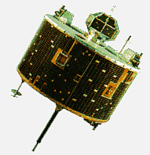
Back هايتن Arabic Hiten Catalan Hiten German Hiten Spanish هیتن Persian Hiten Finnish Hiten French Hiten Galician היטן HE Hiten Hungarian
 Hiten spacecraft | |
| Names | MUSES-A (before launch) |
|---|---|
| Operator | ISAS |
| COSPAR ID | 1990-007A |
| SATCAT no. | 20448 |
| Website | ISAS Hiten page |
| Mission duration | 3 years, 2 months and 17 days |
| Spacecraft properties | |
| Launch mass | 197 kg[1] |
| Start of mission | |
| Launch date | 11:46, January 24, 1990 (UTC) |
| Rocket | Mu-3S-II (no. 5) |
| Launch site | Uchinoura Space Center |
| End of mission | |
| Decay date | 18:03:25.7, April 10, 1993 (UTC) |
| Flyby of Moon | |
| Closest approach | 20:04:09, March 18, 1990 |
| Distance | 16,472.4 km (10,235.5 mi) |
| Moon orbiter | |
| Orbital insertion | 13:33, February 15, 1993 |
| Orbital parameters | |
| Periselene altitude | 6.52 Lunar radii |
| Aposelene altitude | 29.42 Lunar radii |
| Inclination | 34.7° |
| Moon impactor | |
| Impact date | 18:03:25.7, April 10, 1993 |
| Impact site | 34°18′S 55°36′E / 34.3°S 55.6°E |
The Hiten spacecraft (ひてん, Japanese pronunciation: [çiteɴ]), given the English name Celestial Maiden[2] and known before launch as MUSES-A (Mu Space Engineering Spacecraft A), part of the MUSES Program, was built by the Institute of Space and Astronautical Science of Japan and launched on January 24, 1990.[3] It was Japan's first lunar probe, the first robotic lunar probe since the Soviet Union's Luna 24 in 1976, and the first lunar probe launched by a country other than the Soviet Union or the United States.[4][5] The spacecraft was named after flying heavenly beings in Buddhism.[6]
Hiten was to be placed into a highly elliptical Earth orbit with an apogee of 476,000 km, which would swing past the Moon. However, the injection took place with a delta-v deficit of 50 m/s, resulting in an apogee of only 290,000 km.[3] The deficiency was corrected and the probe continued on its mission.
On the first lunar swing-by, Hiten released a small orbiter, Hagoromo (はごろも, named after the feather mantle of Hiten), into lunar orbit. The transmitter on Hagoromo failed, and even though ignition of Hagoromo's deceleration rockets was confirmed by ground observation, it could never be confirmed if the spacecraft had successfully inserted itself into lunar orbit or failed to capture, entering a heliocentric orbit.[7] After the eighth swing-by, Hiten successfully demonstrated the aerobraking technique on March 19, 1991, flying by the Earth at an altitude of 125.5 km over the Pacific at 11.0 km/s. Atmospheric drag lowered the velocity by 1.712 m/s and the apogee altitude by 8665 km.[8] This was the first aerobraking maneuver by a deep space probe.[9]: 2 After the ninth lunar swing-by and second aerobraking maneuver on March 30, 1991, the primary mission of the probe was concluded.
- ^ "Hiten". NASA's Solar System Exploration website. Retrieved November 30, 2022.
- ^ Cite error: The named reference
Uesugi 2003was invoked but never defined (see the help page). - ^ a b Cite error: The named reference
nasawas invoked but never defined (see the help page). - ^ "Hiten". NASA NSSDCA. Retrieved January 31, 2023.
- ^ Cite error: The named reference
NASA Hiten-Hagoromowas invoked but never defined (see the help page). - ^ Cite error: The named reference
metmuseumwas invoked but never defined (see the help page). - ^ Cite error: The named reference
nasa2was invoked but never defined (see the help page). - ^ "Muses A (Hiten)". space.skyrocket.de.
- ^ Cite error: The named reference
Siddiqiwas invoked but never defined (see the help page).
© MMXXIII Rich X Search. We shall prevail. All rights reserved. Rich X Search